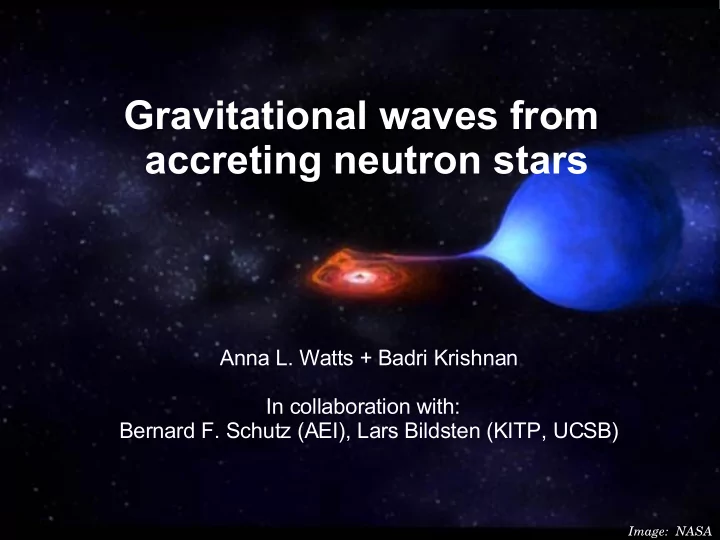

Gravitational waves from accreting neutron stars Anna L. Watts + Badri Krishnan In collaboration with: Bernard F. Schutz (AEI), Lars Bildsten (KITP, UCSB) Image: NASA
Gravitational wave braking Known neutron stars spin more slowly than the values permitted by nuclear theory, despite adequate time for spin-up. Although other mechanisms (magnetic braking) are viable, gravitational wave spin- down could balance accretion torque. Mechanisms Accreted (magnetic?) mountains Accretion-induced density variations Internal oscillations Could these periodic sources be detectable by future gravitational wave detectors? Initial estimates (Bildsten 98) suggested that they might. Top image: D. Lorimer
Revisiting detection prospects Why now? 12 years of RXTE data – we now have 35 rapidly rotating potential sources, with long flux histories from the ASM. 1 st generation detectors at design sensitivity, 2 nd generation comes on line in the next few years, 3 rd generation design underway. Gravitational wave searches are computationally intensive – need to target effort for Einstein@home. Images: LIGO Scientific Collaboration
Three types of source Accreting pulsars: spin measured directly Burst oscillation sources: mechanism unclear, could be direct or indirect. Probably good to ± 5 Hz. k Hz QPO sources: relation to spin not clear. Image: Nature
Kilohertz QPOs Mendez et al 1998 Most models for QPOs have at least some link to the spin. However, separation varies with accretion rate and there may in fact be no link at all (see recent paper by Mendez & Belloni).
Estimating the 'best case' signal (1) Assume gravitational waves provide the only spin-down against a maximal accretion torque Accretion torque 1 / 2 N a ≈ ˙ M G M R Gravitational wave torque 2 s 5 N g = 32 G Q 5 5 c Then for spin balance, the emitted gravitational wave amplitude is 1 / 4 2 / s s 3 / 4 1 / 2 1 / 2 h = 5.5e-27 R 6 F 300 Hz 8 ergs / cm M 1.4 10 Using current LIGO detection criteria (<1% false alarm rate, <10% false dismissal rate), for a coherent search, this has to beat (at a minimum) h det = 11.4 N det T coh 1 / 2 S h
Estimating the 'best case' signal (1) Assume gravitational waves provide the only spin-down against a maximal accretion torque Accretion torque 1 / 2 N a ≈ ˙ M G M R Gravitational wave torque 2 s 5 N g = 32 G Q High fluxes good 5 5 c Then for spin balance, the emitted gravitational wave amplitude is 1 / 4 2 / s s 3 / 4 1 / 2 1 / 2 h = 5.5e-27 R 6 F 300 Hz 8 ergs / cm M 1.4 10 Using current LIGO detection criteria (<1% false alarm rate, <10% false dismissal rate), for a coherent search, this has to beat (at a minimum) h det = 11.4 N det T coh 1 / 2 Long folds good S h
Estimating the 'best case' signal (2) Estimate bolometric fluxes from RXTE ASM (2-10 keV) data – requires spectral modelling. 'Response time' of quadrupole uncertain – so we consider both long-term average fluxes and 'outburst' fluxes for the transients. Start by assuming that we can do long coherent folds of 1-2 years. Assume 'mountain' model so that gravitational wave frequency = 2 x spin frequency For the kHz QPO sources, we pick a frequency in the middle of the observed range of separations.
Internal oscillations R-modes of the fluid core, driven by the Coriolis force, are unstable to gravitational radiation reaction. Mode grows (is unstable) only if it can 'beat' viscosity. Whether the emission is steady or occurs in spurts depends on how you interact with the instability window. There are scenarios (hyperon or strange matter cores) that might put the LMXBs on the 'steady' side of the window. Frequency lower, amplitude higher Image: N. Andersson
Key points There are not many sources above the detection threshold! The kilohertz QPO sources have high fluxes (~ Eddington in many cases) so look the most promising. However they are poorly constrained in terms of spin/orbital parameters. The pulsars do not look promising – burst oscillation sources, with higher fluxes, may be better. What about our accretion model? For the pulsars, should we be considering torque at the (larger) magnetospheric radius? M G M R mag 1 / 2 N a ≈ ˙ This would make things better, but not by a big enough margin (plus we then have to worry about magnetic spin-down as well). What about spin balance? There could be transient periods where gravitational wave emission 'beats' accretion torque – but if the spin varies then this would make it harder to do a coherent fold.
Coherent folding and uncertainty We need to know spin, orbital parameters and sky position The number of signal templates associated with parameter uncertainty impacts both statistics and computational cost. Spin uncertainty – start with an optimistic view Orbital parameters (period, projected semi-major axis, reference time) – harder! Other more indirect constraints from e.g. Assuming Roche lobe Pulsars – can measure directly overflow, rotational broadening Other sources – some have of lines in donor star, X-ray burst dips/eclipses, can use properties, mass transfer rates... photometry or spectroscopy. Image: Cococubed
Now over to Badri....
Recommend
More recommend